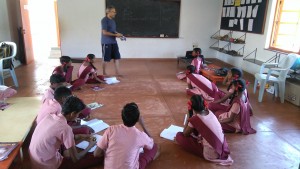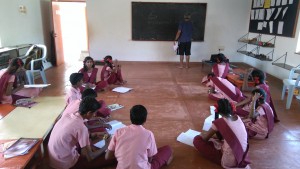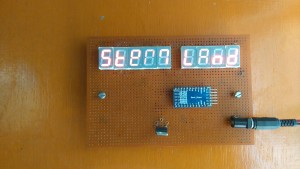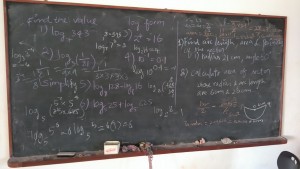We started to build the robot to solve rubik’s cube with python as platform in the STEM land. At that time Yuvaraj (8th grader) wanted to solve it. He searched for the algorithm to solve rubik’s cube. It took him 3 classes to solve the cube for the first time by following the steps. He was very happy and excited about his work and he showed it to other students also. Initially they were all looked at him as Genius and that moment made him to to solve the cube without looking at the algorithm after the continuous one week of hard work with passion. Suddenly, this made an impact in STEM land activities. Every child wanted to learn it but the bad news was we had only one cube in the STEM at that time. So Sanjeev bought some cubes (bumb cubes, speed cubes and 4×4 cube) for STEM land through Asha grant. Almost all the students started to work on it. They helped each other to solve it regardless of grades. Presently there are 18 students who can solve rubik’s cube and few students can solve less than 2 minutes. For me its all about inspiration. None of us asked Yuvaraj to solve it but he took the effort on seeing us building robot. No one asked other students to pick it up but they picked it up on seeing Yuvaraj solving the cube. This is how STEM land works…. The following video was demonstrated by Rathinavelu.
Bangalore Days – My Internship on “Toys from Trash”
I went to Bangalore to do an internship on “Toys from Trash”(Aravind Gupta Toys). I did the Internship at SchoolGuru(located at Malleshwaram in Bangalore). Procheta was my practioner. The timing was from 10am-5pm.I did some 21 toys by watching the videos on youtube. After I finished each toy, Procheta and I we would discuss about the toy like how it will work and what principle it is based on,were it would be used and all. After a week Procheta,Vishal(another practioner)and I conducted a small workshop for the kids in Pura Fountain (Appartment in Marathalli,near Marathalli Bridge) . There were about 12-15 kids(age- 8 to 12 years old) , we conducted the workshop for three days. Each day we did some 5 toys. The kids really enjoyed making the toys and also enjoyed playing with it.
Then I went to Azhim Premji University(Electronic city,Inside PES College Campus) on 11th and 12th with my team (Vishal,Procheta and Me) were we attended a workshop conducted by Vikas Maniar on “Learning Maths from Trash Toys”. We made Counters, 2D blocks, Arrow Cards , Money Cards , Place Value Cards and Abacus and some more materials using waste cardboard sheets, small wood piece, nuts,cycle spoke and color paper to teach children(primary section) about numbers and addition, subtraction, division and multplication. How the children can find their own way in recognising the pattern and their own way of solving the problem was the main goal of our work.
On 13th Friday we conducted a workshop at Thermo Fisher Scientific(A company which helps Researcher in their research field) for 18 students(from 7th-10th Grade) from rural school and even some of the employees attended the workshop with their children. Then in the afternoon we went to NIAS(National Institute of Advanced Science which is situated inside IISC-Indian Institute of Science Campus) where Procheta and Vishal gave a small demonstration to the kids there and after we conducted a workshop for the kids to make the toys. The kids were so excited and they were asking lot of questions.
My Reflections:
I learned many things from making the toys,how to be organized when conducting workshops and how efficiently I am able to work. First, we would discuss what toys that we will do with the children in the workshops. Once, it is finalised we would take the materials and arrange the materials and take it to the place where we would have the workshop. Then we will first distribute the materials needed for the first toy and we w it will do the toy one step at a time. First, we will do it and the children would see it and then they will do it. Once, the toy is finished we all would discuss about the toy how it works and why it works. This is where the children starts thinking and asks question. After that they go and play with the toy. I would like to see going forward by taking session on how I conducted the Workshops with my team(Aura Auro Design) and teach the childrens in school. It was a nice experience that I had in Bangalore. I would like to use the experience that I got in my work space.
Internship at Aura semiconductors, Bangalore
We spent two weeks as interns at Aura semiconductors, Bangalore. Staying, food and travel was taken care by Aura.
Things that I noticed differently:
I saw people working for a long time from 10 to 13 hours a day. They worked very focused and as teams. Problems were brought together and discussed between them. I noticed that they did not move to the next solution instead they stayed with the problem. People reviewed their work often.
What I learned:
This was a learning experience for me and I leaned a lot by simply noticing other people work. People had their own style of coding. I learned to think logically. This really helped me to move faster (than before) and I noticed that logical thinking helps a lot in coding. My four main learning are
1. Never hard code
2. Make the code as general as possible
3. Comment and give meaningful names to your variables so that it helps others understand what the line does. Even it helps my own self if I look at the code after some period of time.
4. Write down all the comments first before I start coding and have an idea of what the code should have. Write it in simple English.
In fact I learned lot more other stuffs.
What will I do differently:
I will interact more with my team and learn from each other.
Other cool stuffs of Bangalore:
There are lot of places where you can hang out. Living is too expensive. There are many job opportunities for graduates in Bangalore especially Engineers.
Stemland Guests
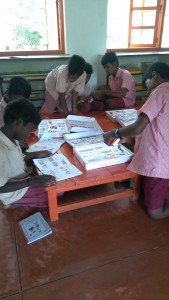
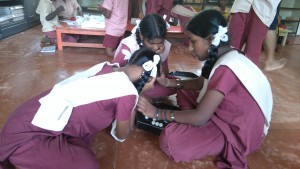
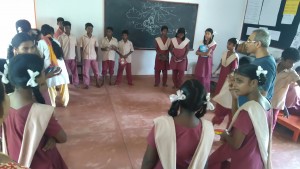
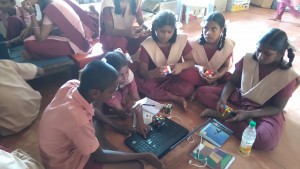 Children from Govt school, Edayanchavadi visited us one day in April 2016. They interacted with Udavi children. Some of them showed them how to do the Rubiks cube. They were taught Abalone and other games. Some made the Bigshot cameras and some worked on a robot that was transferred into a guitar. Looked like they had good fun!
Children from Govt school, Edayanchavadi visited us one day in April 2016. They interacted with Udavi children. Some of them showed them how to do the Rubiks cube. They were taught Abalone and other games. Some made the Bigshot cameras and some worked on a robot that was transferred into a guitar. Looked like they had good fun!
Bangalore Naatkal – May 2016
I spent two full weeks at Aura Semiconductor, Bangalore as an Intern. Most of the days we were in office from 8:30am to 7pm. These two weeks for me was more about learning and noticing how people at Aura work efficiently. Though I got some work done, the trip for me personally was about my growth and learning to work more in a professional way.
I noticed that everyone there work very well as a team. There is lots of team work involved. People talk to each other a lot. They sit with each other and clear their doubts. They maintain Revision control system. People checkout and checkin from that. They all had certain long time goals and plans which they wanted to achieve. People are very helpful at Aura. They seem to acknowledge each other very well too. Not all are always glued to the computer. They also take some time off having some coffee etc..
I learnt that whenever I am stuck with something and cant proceed further I should talk to others and ask for help. I should value other people’s time. I was adding comments to my code which I wasn’t doing before. I am learning to write code in a sensible manner and not add unwanted lines. I also learnt how powerful formulas can be once they are applied in a code.
The experience for me was very different spending nearly 11-12 hours day in office. Sometimes I missed Stemland and school during the day. But the days never felt that tiring when compared to Aura Auro. Maybe because of the AC, snacks, coffee and people staying late 🙂
Installation of standalone python34
STEP1:
Download python34 (python3.4.0 msi) from following website,
https://www.python.org/downloads/release/python-340/
After you have installed it go to command terminal(cmd) and put this python in your path as first priority
PATH=C:\Python34;C:\Python34\Scripts;%PATH% (or)
Go to Control Panel -> System and Security -> System -> Advanced system settings -> environment variables -> system variables -> path and paste C:\Python34;C:\Python34\Scripts;
STEP2:
Download PySide-1.2.4-cp34-none-win32.whl from https://pypi.python.org/pypi/PySide/1.2.4
In the cmd, cd into the directory where PySide-1.2.4-cp34-none-win32.whl is present and run,
pip install PySide-1.2.4-cp34-none-win32.whl
STEP3:
Download spyder2.3 from https://pypi.python.org/pypi/spyder/2.3.0
In the cmd,
cd spyder-2.3.0
python setup.py install
should install your spyder in the python setup.
STEP4:
Download pyinstaller from https://pypi.python.org/pypi/pypiwin32/219
in the cmd,
pip install pypiwin32-219-cp34-none-win32.whl
STEP5:
Download pyinstaller from https://github.com/pyinstaller/pyinstaller/releases
In the cmd,
cd PyInstaller-3.1.1
python setup.py install
STEP6:
Download xlrd package from https://pypi.python.org/pypi/xlrd/0.9.3
In the cmd,
cd xlrd-0.9.4
python setup.py install
STEP7:
Download pyglet package from https://pypi.python.org/pypi/pyglet/1.2.3
In the cmd,
pip install pyglet-1.2.3-py3-none-any.whl
STEP8:
Download psutil( download exe since .whl file didn’t work ) from https://pypi.python.org/pypi/psutil
and run it.
Note:
If you encounter an error saying,
return psutil.phymem_usage().percent AttributeError: ‘module’ object has no attribute ‘phymem_usage’
Open the system.py file:
C:\Python34\Lib\site-packages\spyderlib\utils\system.py
In that file, replace return psutil.phymem_usage().percent line with
return psutil.virtual_memory().percent
StemLand-Name Board
At first the children did a seven segment display(SSD) board which displays StemLand on it by lighting it up using a 9V battery using a corresponding resistor in series. After that we(Anishvathi,Sangeetha,Praveen,Sharmila,Fevina- 8th Grade Students) properly soldered the SSD on a pcb board . We wanted to make the ssd to light up in various ways. So, we used an arduino pro-mini to program the SSD to blink in various ways .We used a battery which was 9V but if we had given the 9V directly it would burn out the arduino board and the SSD.So, we used a 5V voltage regulator which will give us 5V at the output from a 9V input from the battery. Where the output of the regulator is fed to the input of the arduino board. The board worked smoothly. After a few days the battery discharged so we had to change a new battery .
Then Sanjeev gave an idea to make it work using the solar panel . At first Praveen (Student form 8th Grade) and I used one solar panel which did not have enough current to light up the SSDs.So, we used two solar panels in parallel and we got enough current to light up the SSD. Now the board runs in solar energy from the solar panel.
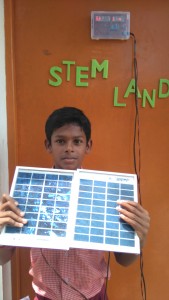 (Praveen holding the solar panel and displaying how it works)
(Praveen holding the solar panel and displaying how it works)
There is also more detail about this Name Board in the link below
http://www.auraauro.com/showcase/name-board-of-stem-land/
Running python3.3 from python 2.7
After installing py33 using the following commands
- conda update conda
- conda create -n py33 python=3.3 anaconda
- activate py33
Some files need to copied over from Anaconda to py33. Click on the link below to download the documentation.
2nd Assessment – 9th grade
Self-Assessment 9th grade
The children of 9th grade were given a self-assessment ‘test’ to make them understand where they are. 4 questions were given on the chapters that they had been working on so far(logarithm and scientific notation). The children were allowed to discuss among them. They graded themselves. We didn’t ask them for marks or how they performed. They would have known it themselves. It was just a reminder on what they are required to know.